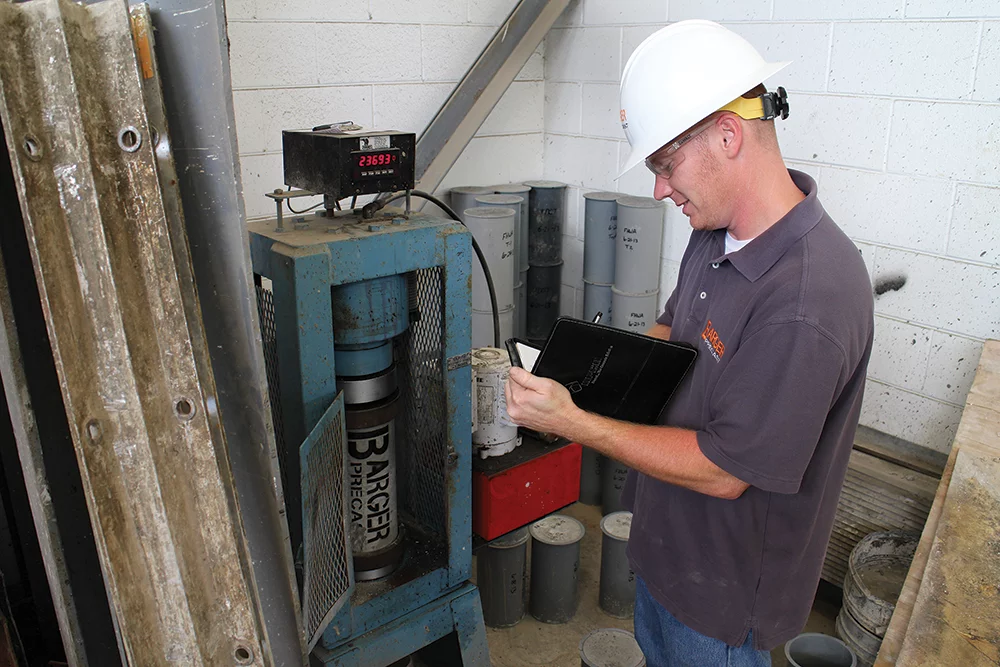The Effectiveness of Concrete Bollards – Protection and Security
The original bollards were crafted using massive tree trunks, or vertical cannon...
The National Precast Concrete Assoc (NPCA) produces outstanding articles and information for specifiers and precasters. As long-standing members, Sanderson Concrete supports the NPCA and encourages architects and engineers to visit the NPCA website for informative articles and information on precast concrete for the construction industry.
By Eric Barger
Throughout the construction industry, the common belief is that concrete takes 28 days to cure and reach 100% of its strength.
This evolved from a misunderstanding of what curing actually means. Some regulators characterize concrete as “green” if it has not cured for a certain time frame, not realizing this leads to unnecessary delays and higher project costs. An evaluation of the concepts of measured compressive strength and curing is in order to shed light on the mystery that surrounds the 28-day myth.
Specifying concrete strength is normally done with a minimum compressive strength (psi) at a certain age (days). Specified concrete compressive strength is the minimum compressive strength at which the concrete should fail in standard tests of 28-day-old concrete cylinders. A typical concrete compressive strength specification requires 4,000 to 5,000 psi at 28 days. Some go a step further and mandate that concrete products cannot be installed or used until 28 days after the date of manufacture. This, mistakenly, has given concrete a reputation among some specifiers as being weak or inferior if it has not cured for the full 28 days.
An arbitrary timeframe
The 28-day period is an arbitrary specimen age – though chosen for many good reasons – for testing the compressive strength of concrete. Specification writing authorities chose 28 days as the standard specimen age to establish consistency for testing procedures throughout the industry (1). Such an arbitrary time frame, however, is not relevant to all mix designs. It is estimated that concrete reaches 75% of this 28-day compressive strength in seven days, and its strength will remain stable or even increase over time (2).
A specific ratio can be determined for each specific mix design and curing process to fine-tune this arbitrary age so that the mix design dictates the 28-day compressive strength. Some mix designs reach 5,000 psi of compressive strength in seven days – or even in 24 hours. However, the faster concrete reaches the minimum design compressive strength, the greater the cost of the concrete.
Strength measurement protocol
Measuring the compressive strength of concrete is achieved by taking a sample of concrete at the time of placement. Cylinders, measuring 12 in. high by 6 in. in diameter, or 8 in. by 4 in., are compressed by a break machine that exerts increasing force upon the cylinder until it structurally fractures. When a failure occurs (commonly referred to as a “break”), the compressive strength is measured by dividing the force (lb) measured at the time the cylinder fails by the load-bearing surface area (sq in.) of the concrete sample. At the time of the break, the sample’s age is generally noted for quality assurance purposes. Therefore, to meet the typical concrete compressive strength specification as previously noted, the break results should calculate to at least 5,000 psi at 28 days.
When a specification has performance criteria of 5,000 psi at 28 days, for example, governing authorities will want a test record (two individual cylinder breaks at 28 days) to ensure conformance with the specification. Fortunately, more than two cylinders are typically collected for testing. Through research and empirical data collection, projection of a 28-day strength from a three- or seven-day test break is easy to perform and results in an estimated strength very close to that measured at 28 days. With the accuracy of this early estimation, if a problem arises, it can be reviewed much sooner than 28 days.
Why curing is misunderstood
Curing is the process of controlling the rate and extent of moisture loss from concrete during cement hydration (3). This would refer to a great many processes that are used to cure concrete, including steam curing, moist curing, air curing and more. It is immediately apparent that the phrase “curing” can have different meanings to different people. Strength and age associations behind the word “curing” are overwhelmingly misunderstood.
Digging deeper into the curing process, hydration is the chemical process that allows concrete to go from a plastic state to a hardened state while gaining strength over time. Hydration occurs at a faster rate in the early stages after concrete placement and slows down after a month or so goes by. Many cement pastes will cease hydration before one year, and some may continue to hydrate over the course of several years (4). Because of the variable length of the hydration process, the phrase “green concrete” is a purely subjective characterization.
With so much variation in hydration time, waiting for completion of the hydration process before testing the compressive strength of concrete would be impractical. In determining a more practical age for testing concrete strength, the 28-day myth began. So, while curing does help the hydration process, “28 days” is not an inclusive rule dictating a specific time to produce minimum compressive strengths. Simply stated, as the concrete cures and hydration takes place, the concrete gets stronger – and hydration may continue long after the minimum required compressive strength is reached.
Curing is a process, not a measure of strength
A specified compressive strength may be for any strength at any age of concrete. There is nothing wrong with specifying 5,000-psi compressive strength at one, seven, 11, 14 or 56 days. It all depends on the mix design, circumstances and project requirements. The American Concrete Institute recognizes 28 days or “the test age designated for determination of the specified compressive strength.”5 Therefore, when a specifier calls for 5,000 psi concrete at 28 days, this tells the concrete producer to select a mix design that will attain a minimum of 5,000 psi 28 days after manufacture.
In precast concrete manufacturing, however, very early attainment of specified strengths – reaching the minimum required compressive strength much sooner than 28 days – is the norm. It is extremely rare for a specifier to require a specific cure time. Rather, specifications might state that installation prior to 28 days is acceptable, provided that two cylinder breaks prove the minimum required compressive strength has already been reached. With a select mix design, concrete could easily reach its minimum required compressive strength one day after it is manufactured and therefore be specification-compliant for installation.
The main thing to remember is that curing is a process and not a measure of concrete strength. The 28-day stipulation provides a consistent industry-wide basis for comparing the compressive strength of concrete products. The 28-day time frame is not directly related to whether or not a specific product meets strength requirements for a particular application. As long as the minimum compressive strength is met before the product is put in service, the time frame to reach the minimum compressive strength should not be relevant.

Resources
The original bollards were crafted using massive tree trunks, or vertical cannon...
Utilizing Precast Concrete Picnic Tables and Continue Learning! Covid-19 has pushed us...
Economical method of reducing maintenance cost! Keep your plants healthy and beautiful...
We are currently experiencing technical issues with our website. Please call us for assistance. We apologize for any inconvenience.


